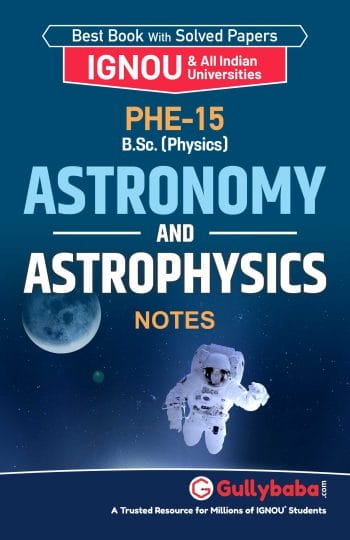#1 Best Selling IGNOU PHE-15 Help-Book & Study-Guide in IGNOU Marketplaces.
Get Good Marks in your B.Sc. Physics Programme in the Term-End Exams even if you are busy in your job or profession.
We've sold over 39,560,157 Help Books and Delivered 48,142,260 Assignments Since 2002.
As our customers will tell you...yes, it really result-oriented.
IGNOU PHE-15 Code Details
-
University
IGNOU (Indira Gandhi National Open University)
-
Title
Astronomy and Astrophysics
-
Language(s)
English
-
Code
PHE-15
-
Subject
Physics
-
Degree(s)
B.Sc.
-
Course
Core Courses (CC)
IGNOU PHE-15 English Topics Covered
Block 1 - Basics of Astronomy
- Unit 1 - Astronomical Scales
- Unit 2 - Basic Concept of Positional Astronomy
- Unit 3 - Astronomical Techniques
- Unit 4 - Physical Principles
Block 2 - The Solar System and the Stars
- Unit 1 - The Sun
- Unit 2 - The Solar Family
- Unit 3 - Stellar Spectre and Classification
- Unit 4 - Stellar Structure
Block 3 - From Stars to Our Galaxy
- Unit 1 - Star Formation
- Unit 2 - Nucleosynthesis and Stellar Evolution
- Unit 3 - Compact Stars
- Unit 4 - The Milky Way
Block 4 - Astronomy and Astrophysics
- Unit 1 - Galaxies
- Unit 2 - Active Galaxies
- Unit 3 - Large Scale Structure and the Expanding Universe
IGNOU PHE-15 (January 2022 - December 2022) Assignment Questions
1. a) Express the distance of the star Proxima Centauri from the star Sirius B and the planet Earth in light years.
b) Draw the celestial sphere and show the observer’s meridian, zenith, celestial equator and the horizon for an observer at latitude 30°N. Show the horizon coordinates of a star X on the celestial sphere for this observer. Would these coordinates be the same at latitude 60°N?
c) Which telescope, optical or X-ray, would have higher resolving power for the same aperture? Calculate the magnitude of the faintest object that a 15 m optical telescope can detect.
d) The average temperature of the interior of a sun-like star is of the order 108 K. Estimate the mass of the star in terms of the solar mass if it has a radius of order 10 10 cm.
2. a) List different layers of the Sun’s atmosphere. Explain why the temperature in the chromosphere increases with height. How is solar wind generated?
b) If the pressure in the solar atmosphere is 104 Pa, calculate the strength of the magnetic field required to balance it (pressure).
c) State nebular hypothesis. Explain the formation of solar system as per the nebular model.
3. a) Discuss Jeans criterion for the formation of stars and obtain an expression for Jeans mass and Jeans length.
b) A supernova explosion takes place at the distance of 4 pc. If the absolute magnitude of the supernova is -25, calculate its apparent magnitude. Will the supernova be brighter than the Sun? Justify your answer.
c) Discuss the qualitative difference between a main sequence star and a compact star. Show that, as the mass of the white dwarf increases, its radius decreases.
4. a) Distinguish between spiral and barred spiral galaxies giving examples of each type of galaxy.
b) What is a Seyfert galaxy? Explain how broad-line and narrow-line regions originate in a Seyfert galaxy.
c) Using the virial theorem, explain why there is a need to postulate the existence of dark matter.
d) A galaxy of absolute magnitude of -20 is at a distance of 100 kpc. Would it be visible to the naked eye?
Buy PHE-15 Assignment
